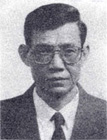

 Wang Enbi (1938- ) is a native of Anhui province. He graduated from East China Branch University of Amateur, Chinese Academy of Sciences with a major in biochemistry. He had been working in Shanghai Cytobiology Research Institute. He had once been engaged in the research on the relations between breast cancer and endocrine hormone. Since 1969, he joined the research on yeast alanine transfer ribonucleic acid (tRNAala). As a team leader, he was engaged in development of mononucleotide, protection of monomer, synthesis of small section. In 1975, he developed synthesis of deoxy 10 nucleotide and deoxy 13 nucleotide. As a leader of nucleic acid project, he also developed a DNA polymerase and RNA enzyme. In 1980, total synthesis of tRNAala was successfully prepared, which won CAS Significant Science and Technology Award, First Class (1984), and State Natural Science Awards, First Class (1987). In 1982, he joined study of post-processing of product of original genetic engineering of insulin human. In 1987, he joined post-processing of expression product of growth hormone genetic engineering, product appraisal, and determination of activity, etc.
Wang Enbi (1938- ) is a native of Anhui province. He graduated from East China Branch University of Amateur, Chinese Academy of Sciences with a major in biochemistry. He had been working in Shanghai Cytobiology Research Institute. He had once been engaged in the research on the relations between breast cancer and endocrine hormone. Since 1969, he joined the research on yeast alanine transfer ribonucleic acid (tRNAala). As a team leader, he was engaged in development of mononucleotide, protection of monomer, synthesis of small section. In 1975, he developed synthesis of deoxy 10 nucleotide and deoxy 13 nucleotide. As a leader of nucleic acid project, he also developed a DNA polymerase and RNA enzyme. In 1980, total synthesis of tRNAala was successfully prepared, which won CAS Significant Science and Technology Award, First Class (1984), and State Natural Science Awards, First Class (1987). In 1982, he joined study of post-processing of product of original genetic engineering of insulin human. In 1987, he joined post-processing of expression product of growth hormone genetic engineering, product appraisal, and determination of activity, etc.
TOTAL SYNTHESIS OF YEAST ALANINE TRANSFER RIBONUCLEIC ACID
Wang Debao
(Shanghai Institute of Biochemistry, Chinese Academy of Sciences)
Abstract
Yeast alanine transfer ribonucleic acid (tRNAy(Ala)) consists of 76 nucleotides. In addition to the 4common nucleotides, A, G, C and U, this tRNA contains 9 modified nucleotides of 7 different species, m1G, D, m22G, I, m1I, and T. By a combination of chemical and enzymatic methods, small oligonucleotides with lengths varying from 2 to 8 nucleotides were synthesized from mononucleotides and nucleosides. The small oligonucleotides were then phosphorylated at the 5'-end with adenosine triphosphate (ATP) in the presence of polynucleotide kinase and the 5'-phosphorylated oligonucleotides were used as donors. Donors and suitable acceptors, oligonucleotides with 3'- free hydroxyl group, were ligated by T4 RNA ligase into 6 large oligonucleotides of 13, 9, 13, 10, 12 and 19 nucleotides in lengths. These oligonucleotides were further phosphorylated at their 5'-ends and ligated to form two half molecules with 35 and 41 nucleotides respectively. Finally, the two half molicules were again phosphorylated at their 5'-ends, annealed and ligated to obtain the whole molecules of tRNAy(Ala). Prior to this, two semisyntheses were performed, i.e. ligation of the synthetic 5'-half molecule with the natural 3'-half molecule and that of the natural 5'-half molecule with the synthetic 3'-half molecule.
Both the semi-synthetic tRNAy(Ala) and the synthetic tRNAy(Ala) occupy the same position as the natural tRNAy(Ala) after electrophoresis on a 20% polyacrylamide gel. They have the same chemical composition (containing 9modified nucleotides of 7different species) and structure as the natural tRNAy(Ala) and are biologically active, i.e. accepting and transferring alanine into proteins in a cell-free protein synthesizing system, the accepting activity of the synthetic product is 52-66%of that of the natural tRNAy(Ala) and 91-106% of that of the reconstituted product of the two natural half molecules. The incorporation activity of alanine into proteins of the synthetic 3H-alanine tRNAy(Ala) is 63%, corresponding to 91% of that of the natural tRNAy(Ala) and 115%of that of the reconstituted product of the two natural half molecules.
Both common and modified nucleotides and nucleosides, protecting and condensing reagents for chemical synthesis and enzymes for enzymatic synthesis and biological activity tests were all prepared.
To the best of our knowledge, this is the first time that a natural RNA with biological activity is synthesized.